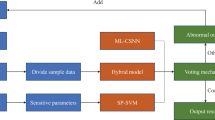Abstract
Establishing an effective early warning mechanism for the rocket final assembly process (RFAP) is crucial for the timely delivery of rockets and the reduction of additional production costs. To solve the unsystematic design of warning indicators and warning levels in RFAP and address the problem of low warning accuracy caused by imbalanced data distribution, this paper redesigns the warning indicators and warning levels in a systematic way, and develops a novel multiclass imbalanced learning method based on dynamic sampling algorithm (DyS) and improved ensemble neural network (IENN). The DyS algorithm dynamically determines the training set after oversampling the minority class, while the IENN can effectively suppress the oscillation in the iterative process of the DyS algorithm and improve the overall classification accuracy by removing the redundant and ineffective networks from the ensemble neural network. The experiment results indicate that the proposed method outperforms other methods in terms of accuracy and stability for early warning of tardiness in RFAP.








Similar content being viewed by others
Explore related subjects
Discover the latest articles, news and stories from top researchers in related subjects.References
Abdi, L., & Hashemi, S. (2015). To combat multi-class imbalanced problems by means of over-sampling techniques. IEEE Transactions on Knowledge and Data Engineering, 28(1), 238–251.
Cao, X., & Lam, J. S. L. (2018). Simulation-based catastrophe-induced port loss estimation. Reliability Engineering & System Safety, 175, 1–12.
Chawla, N. V., Lazarevic, A., Hall, L. O., & Bowyer, K. W. (2003). SMOTEBoost: Improving prediction of the minority class in boosting. In European conference on principles of data mining and knowledge discovery (pp. 107–119).
Chen, S., He, H., & Garcia, E. A. (2010). RAMOBoost: Ranked minority oversampling in boosting. IEEE Transactions on Neural Networks, 21(10), 1624–1642.
Gonzalez-Val, C., Pallas, A., Panadeiro, V., & Rodriguez, A. (2020). A convolutional approach to quality monitoring for laser manufacturing. Journal of Intelligent Manufacturing, 31(3), 789–795.
Guo, H., Li, Y., Shang, J., Gu, M., Huang, Y., & Gong, B. (2017). Learning from class-imbalanced data: Review of methods and applications. Expert Systems with Applications, 73, 220–239.
Guo, H., & Viktor, H. L. (2004). Learning from imbalanced data sets with boosting and data generation: the databoost-im approach. ACM SIGKDD Explorations Newsletter, 6(1), 30–39.
Gürbüz, F., Eski, İ., Denizhan, B., & Dağlı, C. (2019). Prediction of damage parameters of a 3PL company via data mining and neural networks. Journal of Intelligent Manufacturing, 30(3), 1437–1449.
He, H., & Garcia, E. A. (2009). Learning from imbalanced data. IEEE Transactions on Knowledge and Data Engineering, 21(9), 1263–1284.
Jain, A. K., & Lad, B. K. (2019). A novel integrated tool condition monitoring system. Journal of Intelligent Manufacturing, 30(3), 1423–1436.
Joseph, A. (2011). Tsunamis: Detection, monitoring, and early-warning technologies. Cambrige: Academic Press.
Kotsiantis, S. B., Zaharakis, I. D., & Pintelas, P. E. (2006). Machine learning: a review of classification and combining techniques. Artificial Intelligence Review, 26(3), 159–190.
Krawczyk, B., Woźniak, M., & Schaefer, G. (2014). Cost-sensitive decision tree ensembles for effective imbalanced classification. Applied Soft Computing, 14, 554–562.
Krogh, A., & Vedelsby, J. (1995). Neural network ensembles, cross validation, and active learning. In Advances in neural information processing systems (pp. 231–238).
Lin, M., Tang, K., & Yao, X. (2013). Dynamic sampling approach to training neural networks for multiclass imbalance classification. IEEE Transactions on Neural Networks and Learning Systems, 24(4), 647–660.
Qin, W., Zha, D., & Zhang, J. (2018). An effective approach for causal variables analysis in diesel engine production by using mutual information and network deconvolution. Journal of Intelligent Manufacturing, 9, 1–11.
Ramezani, A., & Rothe, H. (2017). Simulation-based early prediction of rocket, artillery, and mortar trajectories and real-time optimization for counter-RAM systems. Mathematical Problems in Engineering, 12, 1–8.
Rojas, R. (2013). Neural networks: a systematic introduction. Berlin: Springer.
Rui, Z., Qi, L., Yue, Z., Jin-Cun, C., & Li-Hui, A. N. (2016). Study on lean management of carrier rocket final assembly based on the process. Industrial Engineering and Management, 21(2), 108–111.
Sheng, X., Zhao, X., Zhang, P., Zhang, J., Cheng, H., Liu, S., et al. (2019). A stacked auto-encoder based approach for rocket final assembly cycle time prediction. Computer Integrated Manufacturing Systems, 11, 2720–2730.
Tan, X., Xing, L., Cai, Z., & Wang, G. (2020). Analysis of production cycle-time distribution with a big-data approach. Journal of Intelligent Manufacturing. https://doi.org/10.1007/s10845-020-01544-7.
Wang, J., Xiong, X., Li, Z., Wang, W., & Zhu, J. (2016a). Wind forecast-based probabilistic early warning method of wind swing discharge for OHTLs. IEEE Transactions on Power Delivery, 31(5), 2169–2178.
Wang, J., Xiong, X., Zhou, N., Li, Z., & Wang, W. (2016b). Early warning method for transmission line galloping based on SVM and AdaBoost bi-level classifiers. IET Generation, Transmission and Distribution, 10(14), 3499–3507.
Wang, J., Yang, Z., Zhang, J., Zhang, Q., & Chien, W. T. K. (2019). AdaBalGAN: An improved generative adversarial network with imbalanced learning for wafer defective pattern recognition. IEEE Transactions on Semiconductor Manufacturing, 32(3), 310–319.
Wang, J., & Zhang, J. (2016). Big data analytics for forecasting cycle time in semiconductor wafer fabrication system. International Journal of Production Research, 54(23), 7231–7244.
Wang, J., Zhang, J., & Wang, X. (2017). Bilateral LSTM: A two-dimensional long short-term memory model with multiply memory units for short-term cycle time forecasting in re-entrant manufacturing systems. IEEE Transactions on Industrial Informatics, 14(2), 748–758.
Wang, J., Zhang, J., & Wang, X. (2018). A data driven cycle time prediction with feature selection in a semiconductor wafer fabrication system. IEEE Transactions on Semiconductor Manufacturing, 31(1), 173–182.
Wen, L., Li, X., Gao, L., & Zhang, Y. (2017). A new convolutional neural network-based data-driven fault diagnosis method. IEEE Transactions on Industrial Electronics, 65(7), 5990–5998.
Wilhite, D. A. (2012). Drought assessment, management, and planning: theory and case studies: Theory and case studies. Berlin: Springer.
Xiong, X., Weng, S., & Wang, J. (2014). An online early-warning method for wind swing discharge of the conductor toward the tangent tower and jumper toward the strain tower. IEEE Transactions on Power Delivery, 30(1), 114–121.
Yuan, Z., Wang, Y., & Sun, C. (2017). Construction schedule early warning from the perspective of probability and visualization. Journal of Intelligent & Fuzzy Systems, 32(1), 877–888.
Zhang, Y., Li, X., Gao, L., Wang, L., & Wen, L. (2018). Imbalanced data fault diagnosis of rotating machinery using synthetic oversampling and feature learning. Journal of Manufacturing Systems, 48, 34–50.
Zhang, C., & Ma, Y. (2012). Ensemble machine learning: Methods and applications. Berlin: Springer.
Zhang, Y., Xu, Y., Dong, Z. Y., Xu, Z., & Wong, K. P. (2017). Intelligent early warning of power system dynamic insecurity risk: Toward optimal accuracy-earliness tradeoff. IEEE Transactions on Industrial Informatics, 13(5), 2544–2554.
Zheng, Y. J., Chen, S. Y., Xue, Y., & Xue, J. Y. (2017). A Pythagorean-type fuzzy deep denoising autoencoder for industrial accident early warning. IEEE Transactions on Fuzzy Systems, 25(6), 1561–1575.
Zheng, G., Zhu, N., Tian, Z., Chen, Y., & Sun, B. (2012). Application of a trapezoidal fuzzy AHP method for work safety evaluation and early warning rating of hot and humid environments. Safety Science, 50(2), 228–239.
Zhou, Z. H., & Liu, X. Y. (2005). Training cost-sensitive neural networks with methods addressing the class imbalance problem. IEEE Transactions on Knowledge and Data Engineering, 18(1), 63–77.
Zhou, Z. H., Wu, J., & Tang, W. (2002). Ensembling neural networks: Many could be better than all. Artificial Intelligence, 137(1–2), 239–263.
Zhou, Q., Yan, P., Liu, H., & Xin, Y. (2019). A hybrid fault diagnosis method for mechanical components based on ontology and signal analysis. Journal of Intelligent Manufacturing, 30(4), 1693–1715.
Acknowledgements
This research is supported by the National Natural Science Foundation of China under Grant No. 51775348 and No. U1637211.
Author information
Authors and Affiliations
Corresponding author
Additional information
Publisher's Note
Springer Nature remains neutral with regard to jurisdictional claims in published maps and institutional affiliations.
Rights and permissions
About this article
Cite this article
Zhuang, Z., Guo, L., Huang, Z. et al. DyS-IENN: a novel multiclass imbalanced learning method for early warning of tardiness in rocket final assembly process. J Intell Manuf 32, 2197–2207 (2021). https://doi.org/10.1007/s10845-020-01631-9
Received:
Accepted:
Published:
Issue Date:
DOI: https://doi.org/10.1007/s10845-020-01631-9




